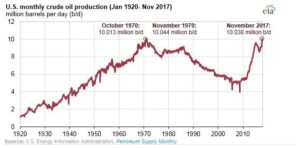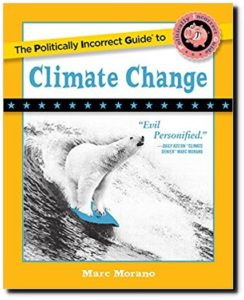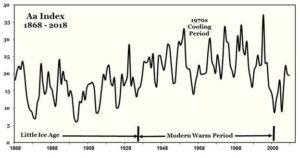by Benny Peiser, March 17, 2018 in GWPF

by J. Cartwright, March 16, 2018 in A. Watts WUWT
WUWT readers may recall this chart which clearly illustrates just how uncertain climate science really is.
t seems that some climate academics are a bit embarrassed that they haven’t been able to pin down climate sensitivity. From EU Horizon Magazine
Climate sensitivity – reducing the uncertainty of uncertainty
by Jon Cartwright
A study published in January 2018 claims to halve the uncertainty around how much our planet’s temperature will change in response to rising carbon dioxide (CO2) levels, potentially giving governments more confidence to prepare for the future.
by Willis Eschenbach, March 16, 2018 in WUWT
Finally, we have the IPCC Likelihood Scale:
Virtually certain – “All my cool scientist friends agree”.
Very likely – “We really hope this is true”.
Likely – “Two climate models out of three agree”.
About as likely as not – “Nobody has a clue”.
Unlikely – “This outcome offends us”.
Very unlikely – “We really don’t want you going down that path”.
Exceptionally unlikely – “Stephen McIntyre said it first so it can’t possibly be true.”
by A. Watts, March 15, 2018 in WUWT
This paper deals with the central argument that skeptics bring up about claims of global warming: How do you separate the temperature signal from the base components like natural variation, human land-use influence, micro-site bias, measurement errors and biases, and other factors to get the “true” global warming signal?
The answer is that you can’t, at least not easily.
With the surface temperature record, it’s somewhat easier since you can observe some of those elements directly and separate them (such as we’ve done in our surfacestations project for land-use microsite biases), but in the ocean, everything is homogenized by the ocean itself. All you can look for is patterns, and try to disentangle based on pattern recognition. That’s what they are trying to do here.
Disentangling Global Warming, Multidecadal Variability, and El Niño in Pacific Temperatures
Authors
Robert C. Wills, Tapio Schneider, John M. Wallace, David S. Battisti, Dennis L. Hartmann
(…)
by James Temple, March 15, 2018 in A. Watts, WUWT
Fifteen years ago, Ken Caldeira, a senior scientist at the Carnegie Institution, calculated that the world would need to add about a nuclear power plant’s worth of clean-energy capacity every day between 2000 and 2050 to avoid catastrophic climate change. Recently, he did a quick calculation to see how we’re doing.
Not well. Instead of the roughly 1,100 megawatts of carbon-free energy per day likely needed to prevent temperatures from rising more than 2 ˚C, as the 2003 Science paper by Caldeira and his colleagues found, we are adding around 151 megawatts. That’s only enough to power roughly 125,000 homes.
At that rate, substantially transforming the energy system would take, not the next three decades, but nearly the next four centuries. In the meantime, temperatures would soar, melting ice caps, sinking cities, and unleashing devastating heat waves around the globe (see “The year climate change began to spin out of control”).
by P. Homewood, March 15, 2015 in NotaLotofPeopleKnowThat
According to the heavily adjusted NOAA data, last month was the fifth warmest February on record in the Central Lakes Division of NY State, with an average mean temperature of 31.4F.
Prior to 1981, the warmest was February 1954, which averaged 29.8F. In other words, NOAA claim that February 1954 was 1.6F colder than last month.
Which all looks very suspicious, because the opposite picture is shown at the high quality station of Ithaca Cornell University (…)
by Larry Hamlin, March 14, 2018 in WUWT
In June 23, 1988 the Senate Committee on Energy and Natural Resources held a hearing addressing the Greenhouse Effect and Global Climate Change.
Among the presenters at this hearing was Dr. James Hansen, Director, NASA Goddard Institute for Space Studies who introduced his infamous and now debunked global surface temperature model results with future temperature projections under three different scenarios of CO2 emissions growth that grossly over exaggerated resulting projected global temperature increases.
by A. Watts, March 14, 2018 in WUWT
From the Snowfalls are now just a thing of the past department and the Finnish Meteorological Institute comes this press release today.
Exceptionally large amount of winter snow in Northern Hemisphere this year
The new Arctic Now product developed by the Finnish Meteorological Institute shows with one picture the extent of the area in the Northern Hemisphere currently covered by ice and snow. This kind of information, which shows the accurate state of the Arctic, becomes increasingly important due to climate change. The Arctic region will be discussed at the Arctic Meteorological Week which begins in Levi next week.
by P. Gosselin, March 14, 2018 in NoTricksZone
German skeptic and weather expert ‘Schneefan’ here writes how climate activist Mark C. Serreze recently announced this year’s sea ice extent was at the smallest all-time area. But since then Arctic temperatures have plummeted and sea ice area has grown to over 14 million square kilometers (…)
by Ohio State University, March 13, 2018 in ScienceDaily
Scientists have revised an estimate of snow volume for the entire continent, and they’ve discovered that snow accumulation in a typical year is 50 percent higher than previously thought. Researchersplace the yearly estimate at about 1,200 cubic miles of snow. If spread evenly across the surface of the continent from Canada to Mexico, the snow would measure a little over 7.5 inches deep.
In the journal Geophysical Research Letters, researchers at The Ohio State University place the yearly estimate at about 1,200 cubic miles of snow accumulation. If spread evenly across the surface of the continent from Canada to Mexico, the snow would measure a little over 7.5 inches deep. If confined to Ohio, it would bury the state under 150 feet of snow.
by Javier, March 13, 2018 in WUWT
So, you still don’t believe small changes in solar activity can significantly affect climate? You know a very cold period during the Little Ice Age coincided with the Maunder Minimum, but you have heard that the Little Ice Age could have had other causes, like volcanoes. You have been told repeatedly that since 1980 solar activity has been decreasing while global temperature has been increasing, so it can’t be the Sun.
Not so fast. There is a vested interest in climate change not being due to the Sun, as the Sun can’t be taxed or prevented from doing what it does. A further problem is that solar physicists have no clue about how the Sun can show centennial or millennial periodicities. As they prefer to talk about what they know, they reject such periodicities, even though we have evidence in cosmogenic records (14C in tree rings and 10Be in ice cores).
And if I tell you that little changes in the Sun have a disproportionate effect on climate you won’t believe me. You shouldn’t believe me. You shouldn’t believe anybody. Science is not about believing. Religion is about believing. So, I propose that you prove to yourself what effect little changes in the Sun have on climate.
by P. Hockenos, November 13, 2017 in FPNews
Yet Germany’s image as selfless defender of the climate, which was once largely deserved, is now a transparent fiction. Germany has fallen badly behind on its pledges to sink its own greenhouse gas pollutants. In fact, Germany’s carbon emissions haven’t declined for nearly a decade and the German Environment Agency calculated that Germany emitted 906 million tons of CO2 in 2016 — the highest in Europe — compared to 902 million in 2015. And 2017’s interim numbers suggest emissions are going to tick up again this year.
by P. Moore, March 13, 2018 in A. Watts, WUWT
Patrick Moore is a Canadian activist, and former president of Greenpeace Canada. Since leaving Greenpeace, which he helped to found, Moore has criticized the environmental movement for what he sees as scare tactics and disinformation, saying that the environmental movement “abandoned science and logic in favor of emotion and sensationalism.” He has sharply and publicly differed with many policies of major environmental groups, including Greenpeace itself on other issues including forestry, biotechnology, aquaculture, and the use of chemicals for many applications. (…)
by PennEnergy Editorial Staff, February 2, 2018
U.S. crude oil production reached 10.038 million barrels per day (b/d) in November 2017, according to EIA’s latest Petroleum Supply Monthly. November’s production is the first time since 1970 that monthly U.S. production levels surpassed 10 million b/d and the second-highest U.S. monthly oil production value ever, just below the November 1970 production value of 10.044 million b/d.
Within the Lower 48 states, November 2017 production reached a record high in Texas at 3.89 million b/d, followed by North Dakota at 1.18 million b/d. Production in the Federal Gulf of Mexico reached 1.67 million b/d, up 14% from the October 2017 level as the region recovered from Hurricane Nate.

by University of Cap Town, March 12, 2018 in ScienceDaily
Early modern humans living in South Africa around 74,000 years ago prospered through the cataclysmic eruption of the Toba supervolcano in Sumatra. The Toba eruption was one of the Earth’s most explosive volcanic events. The environmental effects of this event have been heavily debated, with some researchers having previously proposed that the eruption led to a worldwide volcanic winter that devastated contemporaneous human populations.
An eruption a hundred times smaller than Mount Toba — that of Mount Tambora, also in Indonesia, in 1815 — is thought to have been responsible for a year without summer in 1816. The impact on the human population was dire — crop failures in Eurasia and North America, famine and mass migrations. The effect of Mount Toba, a super-volcano that dwarfs even the massive Yellowstone eruptions of the deeper past, would have had a much larger, and longer-felt, impact on people around the globe (…)
by K. Richard, March 12, 2018 in NoTricksZone
(…) “A recent aerial survey of the Southern Hudson Bay subpopulation concluded that the abundance of polar bears has remained steady since 1986 (943 bears; SE: 174) (Obbard et al., 2015). The survey included the entire coastal range and offshore island habitat of the Southern Hudson Bay subpopulation, except for the eastern James Bay coast. Taken together, the results of the aerial survey and the participant responses from Wemindji and Chisasibi indicate that the local population has remained stable. However, the unanimous responses from participants in Whapmagoostui/Kuujjuarapik suggest that there has been a localized increase in the number of bears near Whapmagoostui/Kuujjuarapik.”
by Dr. B. Peiser, March 12, 2018 in ClimateChangeDispatch
Greens fear that optimism will foster complacency and hence undermine activism. But I find the essays of Pinker and Boisvert inspiring, not enervating.
I plan to assign the essays to my students, who have become quite gloomy lately. These days, despair is a bigger problem than optimism. —John Horgan, Scientific American, 8 March 2018

by Connaissance des Energies, 12 mars 2018
L’ Alliance solaire internationale est une initiative lancée par l’Inde et la France lors de la COP21 qui vise à « augmenter de manière significative la production d’électricité solaire » dans les 121 pays situés en totalité ou en partie entre les tropiques du Cancer et du Capricorne (des pays en voie de développement pour la grande majorité).
(…)
En juin 2017, l’Alliance solaire internationale indiquait que 33 pays avaient signé son accord-cadre et que 6 l’avait ratifié : l’Inde, la France et 4 territoires insulaires (Fidji, Maurice, Nauru, Tuvalu)(5). Il est nécessaire que 15 pays ratifient cet accord-cadre pour qu’il entre en vigueur. En mars 2018, l’Alliance solaire internationale a été officiellement lancée à New Delhi, en présence d’Emmanuel Macron et d’une vingtaine de dirigeants d’Asie, d’Afrique et d’Océanie.
Le gouvernement indien s’est engagé à abriter le secrétariat de l’Alliance solaire internationale pour une durée de 5 ans (jusqu’en 2021).
by Judith Curry, March 9, 2018 inClimateEtc.
This post is motivated by a twitter thread from Andrew Dessler that responds to a recent ruling in the Northern California versus the oil companies lawsuit (discussed previously here) (…)
by P Gosselin, March 6, 2018 in NoTricksZone
I couldn’t possibly recommend the following new book enough: The Politically Incorrect Guide to Climate Change.
It is authored by the person whom leading German center-left “intellectual” weekly Die Zeit once portrayed (black vs white) as the Godfather of the global warming denial and doubt syndicate: Marc Morano of CFACT’s Climate Depot.
by B. Friedlander, January 25, 2018 in CornellChronicle
“Plastics make ideal vessels for colonizing microscopic organisms that could trigger disease if they come into contact with corals,” Lamb said. “Plastic items – commonly made of polypropylene, such as bottle caps and toothbrushes – have been shown to become heavily inhabited by bacteria. This is associated with the globally devastating group of coral diseases known as white syndromes.”
When plastic debris meets coral, the authors say, the likelihood of disease increases from 4 to 89 percent – a 20-fold change. The scientists estimate that about 11.1 billion plastic items are entangled on reefs across the Asia-Pacific region, and that this will likely increase 40 percent over the next seven years.
by David Archibald, March 10, 2018 on WUWT
This recent post discussed the end of the Modern Warm Period and the year that global cooling began. That post was inspired by a comment to a post on WUWT six to eight years ago to the effect that climate is controlled by the Sun’s magnetic flux – no need to worry about much else. The comment seemed to come from a warmer scientist – they are well funded, have plenty of time on their hands, some are smart and idle curiosity would get a few looking into what controls climate. The results would not be published of course. To paraphrase Mussolini, everything within the narrative, nothing outside the narrative, nothing against the narrative. If the Sun’s magnetic flux controls climate, you don’t have to worry about what goes on under the hood – the effect of EUV on the NAO, the GCR flux, the F10.7 flux, any other flux apart from the magnetic flux (…)

by Jo Moreau, 9 mars 2018, in Belgotopia
Complémentairement à l’article de Donna Laframboise, il semblerait que les différents groupes de travail du GIEC n’aient pas la même définition d’un conflit d’intérêt. On peut identifier deux formes principales de conflit d’intérêt : soit l’utilisation d’une étude rédigée par un auteur ou coauteur du GIEC, ce qui revient à publier des études qu’on utilisera ensuite dans une auto-justification, (voir aussi à ce sujet un billet précédent : http://belgotopia.blogs.lalibre.be/archive/2013/01/03/methodes-interpellantes-au-sein-du-giec.html ), soit la présence en ses rangs d’un salarié de l’industrie ou d’un membre ou d’un proche d’une ONG militant dans le domaine idéologico-politique.
On se rappelle que des contributeurs du GIEC, salariés de l’industrie chimique, avaient été accusés par diverses sources de conflit d’intérêt en 2016, que dire alors de membres ou proches d’ONG militantes, qui semblent de plus en plus se substituer aux organes démocratiques dans la direction de nos sociétés…
by Tony Heller, March 10, 2018 in TheDeplorableClimateScience
Global warming is no longer about imaginary global warming. It is now about an imaginary increase in extreme weather.
March of 2012 was very mild in the Eastern US, and NOAA’s Climate Extremes Index counted that as “extreme weather” – declaring 2012 to be the most extreme year on record.
by University of Nevada, March 9, 2018 in ScienceDaily
A UNLV scientist has discovered the first direct evidence that fluid water pockets may exist as far as 500 miles deep into the Earth’s mantle.
Groundbreaking research by UNLV geoscientist Oliver Tschauner and colleagues found diamonds pushed up from the Earth’s interior had traces of unique crystallized water called Ice-VII.
See alos here